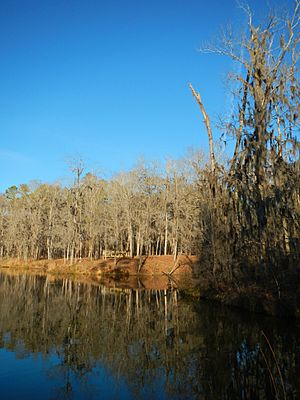Battle of Holy Ground facts for kids
Quick facts for kids Battle of Holy Ground |
|||||||
|---|---|---|---|---|---|---|---|
| Part of the Creek War | |||||||
 The Alabama River at Holy Ground Battlefield Park |
|||||||
|
|||||||
| Belligerents | |||||||
| Red Stick Creek | |||||||
| Commanders and leaders | |||||||
| William Weatherford | Ferdinand Claiborne Pushmataha |
||||||
| Strength | |||||||
| ~320 | ~1,000 | ||||||
| Casualties and losses | |||||||
| ~20-30 killed | 1 killed | ||||||
| Holy Ground Battlefield Park | |
|---|---|
| Location | Lowndes County, Alabama |
|
Alabama Register of Landmarks and Heritage
|
|
| Official name: Holy Ground Battle Site | |
| Designated | May 26, 1976 |
The Battle of Holy Ground, also known as the Battle of Econochaca, was an important fight during the Creek War. It happened on December 23, 1813. This battle was between the United States militia and a group of Creek Indians called the Red Sticks.
The battle took place at Econochaca, which was a strong camp built by Josiah Francis. This camp was located on a high bluff overlooking the Alabama River in what is now Lowndes County, Alabama. The Red Sticks built this camp in the summer of 1813.
Econochaca was one of three camps the Red Sticks built that summer. Creek spiritual leaders also performed special ceremonies there. They believed these ceremonies created a spiritual shield to protect the camp. That's why the name "Econochaca" means "holy ground" or "sacred ground."
Contents
The Battle of Holy Ground
Setting the Stage for Conflict
After earlier battles like the Battle of Burnt Corn and the Fort Mims massacre, General Ferdinand Claiborne started gathering soldiers. His goal was to attack the Red Stick Creeks. By early December 1813, he had about 1,000 men ready. This force included 150 Choctaw warriors led by their chief, Pushmataha.
The Red Stick Creeks, led by William Weatherford, had about 320 men.
The March and the Attack
On December 13, General Claiborne's army left Fort Claiborne and marched towards Holy Ground. By December 22, 1813, they were camped about 10 miles (16 km) south of Econochaca.
When the Creeks learned the army was close, they quickly moved their women and children out of the settlement. On December 23, Claiborne's forces attacked the Red Stick defenses.
Battle and Aftermath
During the battle, between 20 and 30 Red Stick warriors were killed. The U.S. forces lost only one man. Most of the Creeks managed to escape. Their leader, William Weatherford, famously rode his horse, Arrow, over the bluff and into the river while under enemy fire.
After the battle, the U.S. forces destroyed the Red Stick camp. They also burned all the Creek supplies they found. The battle's outcome was considered indecisive, meaning neither side won a clear victory.
Holy Ground Battlefield Park
Today, the battle site is known as Holy Ground Battlefield Park. The United States Army Corps of Engineers maintains this historical park. It was officially added to the Alabama Register of Landmarks and Heritage on May 26, 1976.

